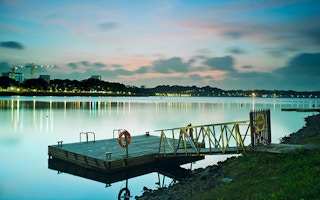The age of water that is simultaneously cheap, abundant and clean is coming to an end.
While most of the world’s major cities were built where they could access stable water sources, overconsumption and climate change have darkened the urban water future. Rising sea levels and more-intense storms threaten both flooding and the contamination of drinking water on an even shorter timescale than expected due to land subsidence from pumping out too much groundwater.
Two global agreements in the past year do offer new collective strategies for dealing with these looming problems. The Paris Agreement finalised at the “COP 21” negotiations last December seeks to prevent the worst impacts of climate change by established commitments from countries to reduce their individual carbon emissions.
In addition, the United Nations’ Sustainable Development Goals (SDGs) are designed to guide international anti-poverty and sustainability efforts over the next decade and a half.
The SDGs include 17 goals and 169 specific targets that could substantially improve prospects for global sustainability. Goal 6, for instance, aims to “ensure availability and sustainable management of water and sanitation for all”. In this, it expands upon the previous iteration of the SDGs, the Millennium Development Goals (MDGs), which oversaw significant progress in drinking-water access globally.
The notable difference on this issue between the MDGs and the SDGs is a new focus on moving toward sustainable water use even as a greater portion of the population gains access.
Urbanisation is correlated with higher rates of water use per capita. As such, cities will be especially impacted by Goal 6 in addition to Goal 11, which explicitly calls for more-sustainable urban spaces. The SDGs came into effect this year.
At the moment, however, we are not on track to meet the water-related SDGs. Demand for water has grown at twice the rate of population growth for more than a century. If consumption continues at current rates, demand will be 40 per cent greater than sustainable supply by 2030, the end date for the SDGs.
Cities can improve this gloomy picture, but it will require a concerted effort by civic leaders to make urban zones more sustainable. Here are four specific areas where cities could make a major contribution to achieving global water-sustainability goals.
Policy, regulations and pricing
Ultimately, urban water sustainability means using less water. One way for cities to do this is through local regulations and water-rate structure changes that encourage greater efficiency.
Even if every place everywhere were able to meet the SDGs and the national commitments of the Paris Agreement, scientists expect us to pass the 2 degree Celsius global average temperature rise that is likely to produce severe impacts from climate change.
It is highly probable that implementation of these accords will be uneven, so it is incumbent on cities to take especially aggressive steps toward sustainability — to do even more than their national governments are asking them to do.
To this end, cities should set their own consumption standards at levels significantly more stringent than those required nationally to meet the SDGs. Leadership here is possible. For example, the water utility in the U. S. capital, DC Water, has partnered with the Water Environment Federation to create a local green-infrastructure-certification programme that credentials green-infrastructure specialists working in the city.
Cities might also raise the requirements for water efficiency in all new developments. How they do this will vary by city — some may change their building codes, while others could create new requirements for developments that get public funding. The worldwide success of “LEED” certification suggests that voluntary award-based certifications can be effective tools for change, as well.
With respect to water rates, cities should set them to more accurately reflect the value of this resource and to encourage better use patterns. Water rates typically aim to cover fixed infrastructure costs and maintenance, and are rarely used to influence consumer behaviour. But utilities should be able to save money through conservation by reducing treatment costs, energy consumption and system wear, and lowering the risk of sewer overflows.
At the same time, water can be priced too low. In such situations, conservation measures would prevent a utility from being able to cover its high fixed costs. This is a problem caused entirely by policy decisions about rate design.
Across the world, water rates are set without much concern about influencing demand. An OECD international survey of utilities found that less than half of them raise the price of a unit of water along with the volume of consumption. And some cities still price water in decreasing block rates in which units become get cheaper the more one uses.
This story was published with permission from Citiscope, a nonprofit news outlet that covers innovations in cities around the world. More at Citiscope.org.








